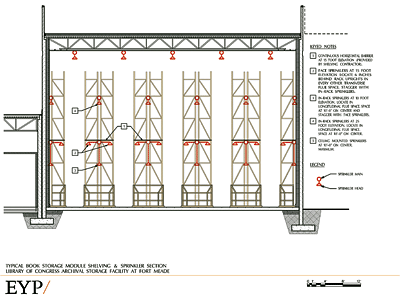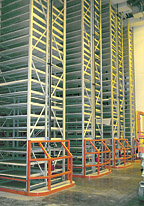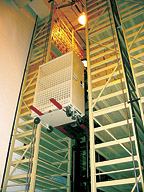
According to Steven J. Herman, the Library of Congress' project manager for the Fort Meade, MD book storage archival facility, "Providing the best possible environmental conditions for the library's collections is critical in meeting our role as a national library and as a source of information for researchers not only for this, but for future generations. Preserving and protecting the collections has long been an issue of critical concern to library management, and the ability to participate in the design and construction of a facility that meets the library's environmental requirements, represents a very positive step in achieving our role as the custodian of the nation's patrimony."
The Architect of the Capitol is responsible for facilities management and all capital improvements on behalf of the United States Congress, including the Library of Congress. Several years ago, a severe book storage capacity shortage led the Architect of the Capitol and Library of Congress to develop plans for a remote archival storage facility with easy access to Washington.
In 1995, a 100-acre site located in Fort Meade was transferred to the U.S. Congress to provide additional storage capacity for the Library of Congress and other legislative bodies. The off-site archival storage facility at Fort Meade is being designed and constructed in phases so that additional storage units or modules can be added when necessary. Construction of the second storage module has recently been completed, and the designs of three additional modules and cold storage for microfilm and photographic materials are now complete. The library intends to build a total of 13 archival storage modules over the next 20 years on the site, with a total of 180,600 gross sq ft of archival storage space.
The archival storage area or "storage module" is similar in nature to a warehouse facility, designed for extremely efficient storage. Each storage module is filled to capacity with rows of 30-foot high shelving; in fact, the building is designed around the shelving. The high-density shelving design maximizes the storage space available by arranging materials by size rather than subject matter. The high-density storage configuration allows 125,000 cubic ft of materials to be placed within a footprint of 12,000 sq ft. Stored materials are accessed using a power-operated lift that travels along the narrow aisles.
Each storage module is designed to preserve and safeguard materials in the collection by maintaining the optimal environmental conditions for archival storage, reducing the long-term preservation costs for this important collection of library and archival materials. Specifically, the major environmental factors that affect the longevity of library and archival materials - temperature, relative humidity, air quality, and light - are controlled using stringent design criteria. A state-of-the-art fire protection system also protects the collections from the catastrophic risk of fire.

Temperature and Humidity
The control of temperature and humidity is vital to promoting the preservation of the archival materials. Cooler temperatures and low relative humidity levels have been shown to significantly extend the life of printed record materials. One of the primary functions of the HVAC system is to provide a stable environment for the records by maintaining a constant space temperature of 50°F (plus or minus 2.5°) and a constant relative humidity level of 30% (plus or minus 5%) year round.The archival storage module HVAC system consists of a constant volume all-air system designed to operate 24/7/365. The system provides 16,000-cfm of conditioned air throughout a module, which is the equivalent of about 2.5 ach. In order to provide redundancy, two 8,000-cfm air-handling systems supply this volume rather than a single 16,000-cfm unit.
Each AHU includes a desiccant dehumidifier providing the dehumidification capacity to maintain optimal humidity for long-term preservation of library and archival materials. The dehumidifiers consist of a wheel that is impregnated with a silica gel desiccant that naturally attracts and holds moisture from gases and liquids. The wheel slowly rotates between two airstreams. The first airstream, known as the "process" airstream, is the supply air that will be delivered to the space. As this air passes across the wheel, moisture is adsorbed, or is held onto the surface of the desiccant, removing it from the airstream. The second airstream, known as the "reactivation" airstream, consists of a higher temperature air that is used to dry the wheel or "reactivate" it by removing the moisture and rejecting it to the outdoors so that the process can be repeated. The dehumidifiers use indirect gas-fired heaters to heat the reactivation airstreams.
By effectively removing the moisture required to maintain the 30% rh level of the space, the desiccant dehumidifiers handle the latent cooling requirements of the space. Hot water and chilled water cooling coils in each AHU satisfy the sensible heating and cooling requirements. A central chilled water and hot water plant provides the necessary 180° hot water and 36° low temperature chilled water.
Redundancy is also a major design criteria for archival storage. Central plant redundancy is based on providing N+1 capacity, meaning that the plant is designed to meet the cooling and heating loads when one chiller or one boiler is out of service. The plant design also allows for additional boilers and chillers when required to meet demand as future storage modules are added.
Electric humidifiers with dispersion manifolds located in the supply air ductwork of each AHU provide the humidification capacity required to maintain the optimal humidity level. The makeup water for humidification is filtered to remove impurities by a reverse osmosis water purification system. In addition to providing "clean" steam for humidification, using purified water also increases the reliability of the humidifiers by reducing scheduled maintenance requirements.
Maintaining tight temperature and humidity level control within a space of this size, with ceilings over 30 ft high, requires a well-distributed air system. Supply and return air are ducted to each aisle to provide good air movement and circulation. The supply and return branch ductwork is centered on alternate shelving ranges. The supply air is distributed high at 13 locations in the center of each aisle and the return air is ducted low from four locations within the shelving of each aisle. Temperature and humidity sensors are located at heights of 5, 15, and 25 ft above the floor at three separate locations within the module for monitoring and control by the BAS.
To minimize the effect of external temperature and humidity fluctuations, the exterior walls consist of 10-in.-thick by 8-ft-wide pre-cast concrete wall panels with 8 in. of rigid insulation. The roof assembly has 5.5 in. of rigid insulation over the concrete composite slab. The well-insulated wall and roof assembly reduces the cooling load and dehumidification requirements of the mechanical system.

IAQ
Both gaseous and particulate air pollutants contribute to the deterioration of library and archival materials. Gaseous pollutants such as sulfur dioxide, nitrogen oxides, and ozone can combine with moisture in the air to form acidic compounds that can damage materials through hydrolysis, and promote oxidative reactions, especially in highly absorbent paper and leather. Paper becomes discolored and brittle, and leather becomes weak and powdery. Particulate pollutants such as dirt, dust, and soot can soil and disfigure materials. In addition to maintaining the desired temperature and humidity levels, the HVAC system also plays an active role in ensuring that proper IAQ is achieved by controlling the particulate and gaseous contaminant levels within the space.To control particulates and gaseous contaminant levels within the storage modules, the Library of Congress established the following stringent design criteria:
- Effective 90% removal of 1-micron particulates;
- Less than 0.38 ppb of sulfur dioxide;
- Less than 2.5 ppb for oxides of nitrogen;
- Less than 12 ppb of ozone; and
- Best available control for hydrochloric acid, acetic acid, and formaldehyde.
Gas-phase filters and high-level particulate filters protect the stored materials from these pollutants. The most common types of gas filter media used for archival storage are potassium permanganate and activated charcoal or carbon. The potassium permanganate media consists of activated alumina impregnated with potassium permanganate and is effective against a broad range of contaminant gases such as sulfur dioxide, nitrogen oxide, nitrogen dioxide, hydrogen sulfide, acetic acid, and formaldehyde. Activated carbon is effective against a broad range of contaminant gases such as chlorine, toluene, acetic acid, ozone, and volatile organic compounds (VOCs).
Because of the need to maintain a highly stable indoor environment and the desire to significantly reduce the level of contaminants introduced into the space, the amount of outdoor air introduced is limited to the amount necessary to meet the space ventilation requirements and to slightly pressurize the space with respect to its surroundings. Further, due to the building site's proximity to a major roadway, a separate outdoor air filtration unit is used to pre-filter the outdoor air before it mixes with the return air from the space.
The outdoor air filtration unit consists of the following components:
- A centrifugal supply fan;
- Two-in. prefilters with a minimum efficiency reporting value (MERV) of 8;
- Final filters with a MERV of 14;
- Two stages of packed-bed gas phase filters of carbon and permanganate; and
- MERV 8 after-filters.
Particulate filters are located downstream of gas-phase filters in order to remove any carryover from the gas phase filters. The packed-bed filters consist of a 12-in. deep bed of potassium permanganate media followed by a 12-in. deep bed of activated carbon. Each bed contains one cubic foot of media for every 50 cfm to 100 cfm of outdoor air. The amount of media and media bed depths used in packed-bed filters allow higher residence times to be achieved (residence time is the time that the airflow is in contact with the media) and as a result higher contaminant removal capacities.
Outdoor air is not, however, the only source of particulate and gaseous pollutants. Even though interior materials were selected to minimize off-gassing, the HVAC system is designed to provide additional protection from any potential off-gassing of materials and particulates generated within the space. The full supply airstream to the module is therefore also filtered to remove particulate and gaseous contaminants that may originate within the building. Similar to the outdoor air filtration unit, the following filter components are provided in each AHU:
- Two inch prefilters with a (MERV) of 8;
- Final filters with a MERV of 14;
- Two stages of blended carbon/potassium permanganate gas phase filters; and
- MERV 8 after-filters.
The blended media gas phase filters consist of 24-in.-wide by 12-in.-high by 12-in.-deep disposable modules. Each module has blended carbon/potassium permanganate media in a one-in. thick "V" pattern to increase the surface area and lower the velocity across the media bed.
In addition to actively removing particulates and gaseous pollutants through filtration, the construction materials used within the module were carefully selected to reduce off-gassing and promote better IAQ. To minimize infiltration of exterior pollutants and moisture, the entire building envelope has a continuous vapor retarder as part of the exterior building assembly design. The interior wall finish consists of gypsum wallboard with water-based latex paint with no VOCs. The super-flat concrete floors are sealed with a low-VOC coating. The use of construction materials that emit formaldehyde, or contain vinyls or polyurethane, was prohibited within the storage module.

Light
An additional source of damage affecting library and archival collections is light. Exposure to light causes fading of dyes and colors, as well as embrittlement and yellowing of paper-based materials. The damage is irreversible. All light to some extent is damaging, but UV light, a form of radiation that is not visible to the naked eye, causes more severe damage in a shorter period of time. To prevent exposure of the collections to natural light, which is high in UV content, the storage modules are designed without any exterior windows or skylights. High-pressure sodium light fixtures that emit very low levels of UV provide artificial lighting within the modules.
Furthermore, the lighting levels are designed to be as low as possible (maintaining 2 ft candles at the lowest shelving level). We also incorporated lighting on the power-operated lift for task lighting needed for operational retrieval of archival material.
Fire Protection
Safeguarding the collections requires a clear understanding of the many overlapping code requirements. Each module is designed to meet the stringent requirements of both the National Fire Protection Association (NFPA) and the National Archives and Records Administration (NARA). The fire protection features of the storage module include fire-rating the walls and roof, compartmentalizing the shelving system to minimize loss in the event of a fire, and providing both an overhead and in-rack sprinkler system.The NARA standards contain specific requirements related to the construction of the building intended to avoid building collapse as a result of fire damage. All walls separating records storage areas from other storage areas must be four-hour fire resistant and exterior walls must be one-hour rated. Archival storage areas are also separated from auxiliary spaces by two-hour rated fire barrier walls. The roof must have a minimum fire resistance rating of 30 minutes, but no more than one hour.
Openings in fire barrier walls separating storage areas from each other must be kept to a minimum. Where such openings were necessary to allow the power-operated lifts to travel from one module to another, they are protected with Class A fire doors to maintain the four-hour rating of the wall. The main structural system consists of exterior precast concrete panels that support the roof structure, eliminating the need for interior columns within the module which NARA requires to be four-hour fire resistant.
The NARA standards also require that the fire protection systems be designed to limit the maximum anticipated loss in any single fire event to a maximum of 300 cubic feet of records. In order to accomplish this goal, the shelving was subdivided into smaller fire areas using steel dividers. A continuous horizontal barrier is located at the 15-ft elevation within the racks to comply with the criteria of NFPA 13. In addition, vertical baffles are provided at 50-ft intervals within the racks as required by Section 9.5.4 of NFPA 909.
The ceiling sprinklers within the module are ordinary temperature (165°) rated, spaced so that the maximum coverage area per sprinkler does not exceed 100 sq ft. Below the overhead sprinklers, three levels of in-rack sprinklers are provided within each row of shelving. The first level of sprinklers is located within the longitudinal flue space at the 10-ft elevation. The second level of sprinklers is located on the aisle side of the rack (face sprinklers) at the 15-ft elevation, just below the horizontal barrier. The third level of sprinklers is located within the longitudinal flue space at the 25-ft elevation. All of the in-rack sprinklers are spaced 10 ft on center. Face sprinklers and longitudinal flue sprinklers are staggered in the vertical plane, three inches behind the rack uprights and a maximum of 18 inches from the front of the rack. The in-rack sprinklers are ordinary temperature (165°) rated, and are provided with water shields and mechanical guards.
Automatic smoke detection is provided throughout the storage module, as required by the NARA Standards. Spot type smoke detectors are located at the ceiling of the storage module. In order to provide increased detection ability with the storage module, smoke detector spacing was reduced to a maximum coverage area per detector of 500 sq ft. In addition, a row of smoke detectors was installed within the longitudinal flue space within each row of racks. This line of detectors is mounted to the underside of the horizontal barrier located at the 15-ft elevation.

